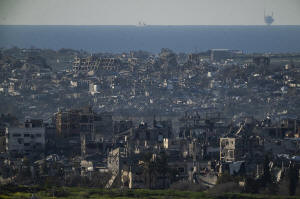With the Gaza ceasefire in limbo, Israel tries to impose an alternative
plan on Hamas
[March 04, 2025]
By JOSEPH KRAUSS
Israel this week introduced what it said was a new U.S. ceasefire plan —
different from the one it agreed to in January — and is trying to force
Hamas to accept it by imposing a siege on the Gaza Strip.
Prime Minister Benjamin Netanyahu referred to it as the “Witkoff
proposal,” saying it came from U.S. President Donald Trump's Mideast
envoy, Steve Witkoff. But the White House has yet to confirm that,
saying only that it supports whatever action Israel takes.
Netanyahu's remarks came a day after the first phase of the negotiated
ceasefire ended, with no clarity on what would come next since the
agreement's second phase has not yet been hammered out.
The new plan would require Hamas to release half its remaining hostages
— the militant group's main bargaining chip — in exchange for a
ceasefire extension and a promise to negotiate a lasting truce. Israel
made no mention of releasing more Palestinian prisoners — a key
component of the first phase.
Hamas has accused Israel of trying to sabotage the existing agreement,
which called for the two sides to negotiate the return of the remaining
hostages in exchange for more Palestinian prisoners, a full Israeli
withdrawal from Gaza and a lasting ceasefire. But no substantive
negotiations have been held.
On Sunday, Israel halted all food, fuel, medicine and other supplies to
Gaza’s population of some 2 million people and vowed “additional
consequences” if Hamas did not embrace the new proposal.
Arab leaders are meanwhile finalizing a separate plan for postwar Gaza
to counter Trump's suggestion that its population be relocated so it can
be transformed into a tourist destination.
But all bets are off if the war resumes.

The existing agreement is in limbo
The ceasefire reached in January, after more than a year of negotiations
mediated by the United States, Egypt and Qatar, laid out a three-phase
plan to return all the hostages taken by Hamas on Oct. 7, 2023, and
ending the war triggered by the attack.
Hamas-led militants killed some 1,200 people that day, mostly civilians,
and took 251 hostage. More than 100 were released in an earlier
ceasefire. Israeli forces rescued eight and recovered dozens of bodies
before the current ceasefire took hold.
During the first, six-week phase, Hamas released 25 living Israeli
hostages and the bodies of eight more in exchange for nearly 2,000
Palestinian prisoners. Israeli forces withdrew from most of Gaza and
allowed an influx of desperately needed humanitarian aid. Each side
accused the other of violations, but the deal held.
Phase 2 was always going to be far more difficult because it would force
Israel to choose between securing the return the hostages and
annihilating Hamas — two of Netanyahu's main war goals.
Hamas, which remains in control of Gaza, has said it will only release
the remaining hostages if Israel ends the war. But that would leave the
militant group intact and with major influence over the territory, even
if it hands over formal power to other Palestinians, as it says it is
willing to do.
The new plan favors Israel
Hamas still has 59 hostages, 35 of whom are believed to be dead. Under
the so-called Witkoff plan, it would release half the hostages on the
first day — apparently without getting anything new in return.
The sides would then have around six weeks — through the Muslim holy
month of Ramadan and the Jewish Passover holiday ending April 20 — to
negotiate a permanent ceasefire and the return of the remaining
hostages.
But with fewer hostages, Hamas' hand would be weakened, and Israel and
the United States are already speaking about new conditions — like the
disarmament of Hamas or the exile of its leadership — that were not part
of the original agreement.
[to top of second column]
|

Buildings destroyed during the Israeli air and ground offensive
stand in the Gaza Strip are seen from southern Israel, Sunday, March
2, 2025. (AP Photo/Leo Correa)

A political lifeline for Netanyahu
Netanyahu's narrow coalition is beholden to far-right allies who
want to eliminate Hamas, depopulate Gaza through what they refer to
as “voluntary emigration” and rebuild Jewish settlements in the
territory. Finance Minister Bezalel Smotrich has threatened to bring
down the government if Netanyahu enters Phase 2 of the existing
agreement and does not resume the war.
The new plan would buy Netanyahu six weeks of breathing room and
enough time to pass a budget by the end of the month — something he
must do to keep his government from automatically falling. If it
falls, elections would be held roughly a year and a half ahead of
schedule and could see him removed from power.
Opposition parties say they would ensure Netanyahu's government is
not brought down over a deal that returns the rest of the hostages.
But that would still weaken him politically.
The American position is unclear
Netanyahu says his government has "fully coordinated" its approach
with the Trump administration, which has publicly endorsed Israel's
war goals, including the eradication of Hamas. But Witkoff has not
said a word in public about the plan that supposedly bears his name,
and U.S. officials did not immediately respond to requests for
comment on Monday.
Trump himself has sent mixed signals about Gaza.
As a candidate, he pledged to end wars in the Middle East, and he
took credit for pushing the ceasefire agreement past the finish line
just before his inauguration.
But he has also expressed revulsion at Hamas' treatment of the
captives and suggested that “all hell” should break loose if they
are not immediately returned, while leaving that decision to Israel.
An Arab counterproposal to Trump's Gaza plan
Trump has also floated the idea of relocating Gaza's roughly 2
million Palestinians to other countries so the U.S. can rebuild it
as a tourist destination. Netanyahu welcomed that proposal, which
was universally rejected by Palestinians, Arab countries and human
rights experts, who warn it could violate international law.
It's hard to see how Trump's Gaza plan would be carried out without
Israel resuming the war and launching an even bloodier offensive
than the last one, which left much of Gaza in ruins and killed over
48,000 Palestinians, according to local health authorities. They say
more than half of those killed were women and children but do not
specify how many of the dead were combatants.
Egypt has developed a counterproposal expected to be endorsed at an
Arab summit in Cairo on Tuesday. Under its plan, Palestinians would
remain in Gaza and relocate to “safe zones” while cities are
rebuilt. Hamas would hand over power to a transitional authority of
political independents while the international community works to
empower the Western-backed Palestinian Authority.
But Israel, which has ruled out any role for the Palestinian
Authority in postwar Gaza, is unlikely to accept such a plan. And
while Trump has called on Arab countries to come up with their own
proposal, it's unclear whether he would go for it either.
___
Associated Press writers Tia Goldenberg in Tel Aviv, Israel, and
Samy Magdy in Cairo contributed.
All contents © copyright 2025 Associated Press. All rights reserved |